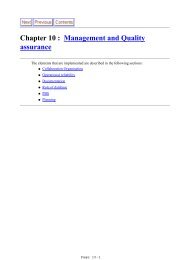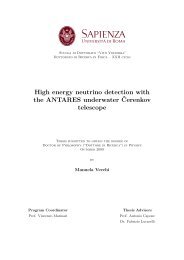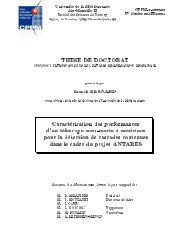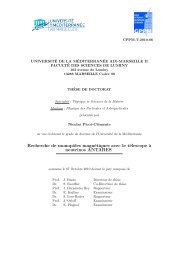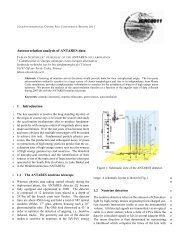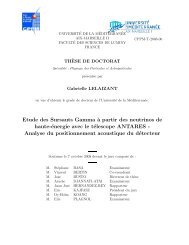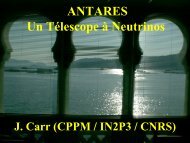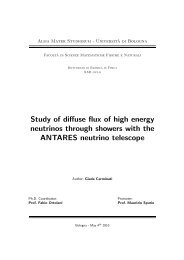Figure 2.17: Conversion factor from muon flux [km −2 ][year −1 ] to spin-dependentcross-section [pb] as a function of the annihilation channel and WIMP mass.Klein particle). The generation of neutrinos is done via the decay of annihilationproduct. Lighter leptons such as electrons will not produce neutrinos, as theyare stable and either they leave the Sun or get absorbed, and for muons they getabsorbed before interacting. The important annihilation channels are: b¯b, c ¯c,t¯t, τ + τ − , W + W − , Z 0 Z 0 , gg. The production of neutrinos is handled withPYTHIA[77], PYTHIA will propagate the particles, ensuring all possible interactionsare taken into account and collects the (anti-)neutrino output. For examplethe b quark hadronize and produce B mesons where in the Sun they will interactbefore they decay, and this needs to be taken into consideration. Additionally,since the actual mass of the WIMP is not known then the neutrino productionsimulation is done for many masses: 10, 25, 50, 80.3, 91.2, 100, 150, 176, 200,250, 350, 500, 750, 1000, 1500, 2000, 3000, 5000, and 10000 GeV. However, theones we will use later in our analysis are: 50, 80.3, 91.2, 100, 150, 176, 200, 250,350, 500, 750, and 1000 GeV. Finally not all channels are equal, some of themhave a very soft spectrum such as the b channel, and some a quite hard such as theτ and W. The main emphasize later in the analysis part of this thesis is to focus onthese three channels as we will not be looking at any model but try to be modelindependent.These three channels will represent the extreme cases of dark matterannihilation. Any model in CMSSM will have varying branching ratio (but never100%) to the different channels, making the whole parameter space of CMSSMlocated between the two limits set by the hard and soft channels.In figure 2.18 we can see the neutrino yield after production for a WIMP mass of200 GeV. We can see a comparison between the three favorite annihilation chan-28
Figure 2.18: Flux of ν µ / ¯ν µ at the Sun’s center after production. The mass ofthe WIMP used here is 200 GeV. A comparison can be seen between the threechannels b¯b, τ + τ − , W + W − and between ν µ and ¯ν µ flux.nels b¯b, τ + τ − , W + W − . It is immediately clear that the b channel is soft with thespectrum peaking at very small values of z (z =E νM WIMP) and diminishing at largervalues. The W channel on the other hand seem to be very hard as the spectrum isalmost constant for all values of z. Finally the τ channel is hard as well but thespectrum starts to fall when the energy of the neutrino is 80% of the mass of theWIMP. However, for smaller values it is roughly constant.Neutrino interactionThe neutrino interaction will be described in the next chapter. While the descriptionis based for rock and sea water (Earth), the underlying physics is the same forneutrino interactions in the Sun.Neutrino oscillationsThe principle of neutrino oscillations scenario is related to the idea that the neutrinoleptonic flavor eigenstates are not the same as the neutrino mass eigenstates.This leads to a mixing scenario where the flavor eigenstate becomes a linear combinationof those of the mass. This oscillation scenario has been verified experimentallyby several experiments such as Super-kamiokande[78, 79], SNO[80],K2K[81], and other.29



